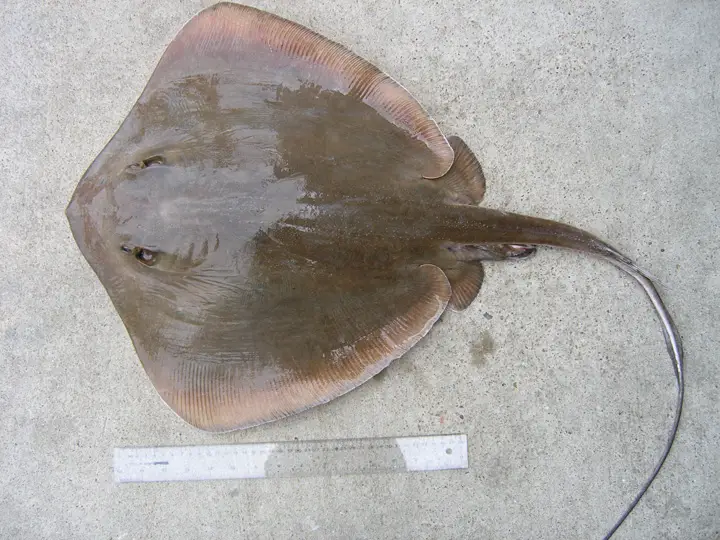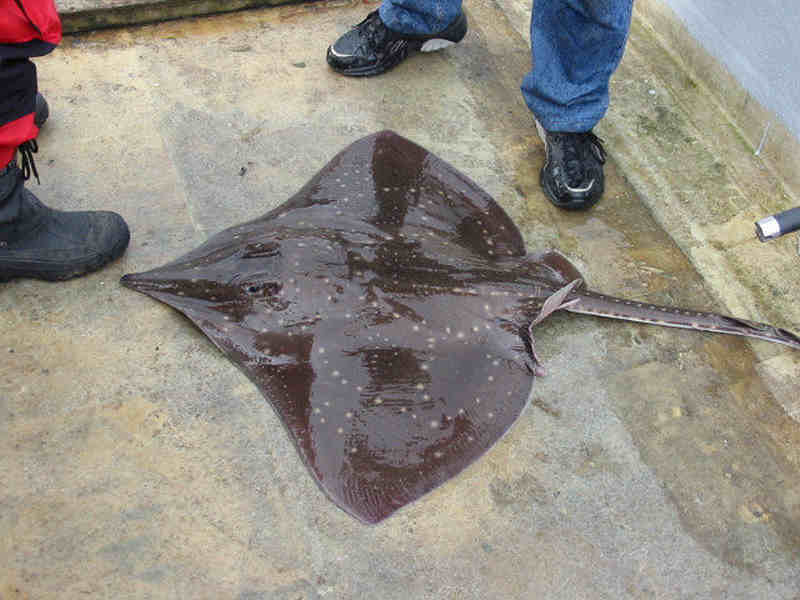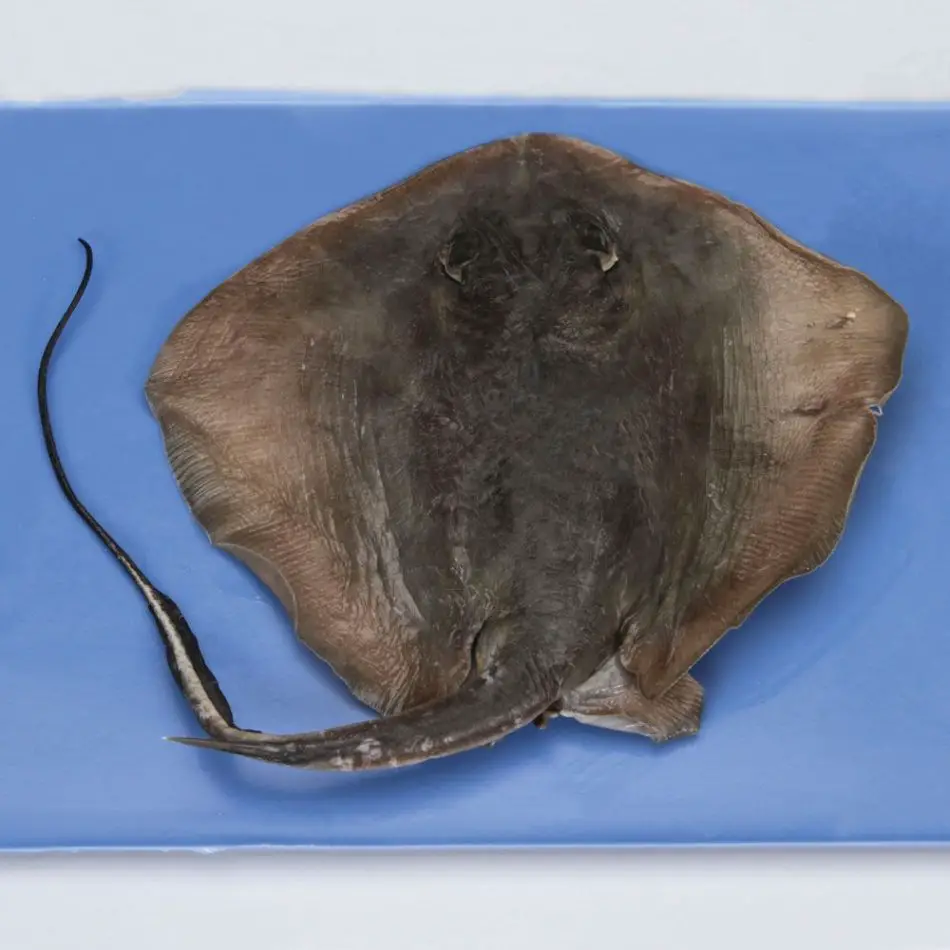If you are a surf fisherman like myself there is no doubt that you have had a run-in with a Stingray, especially in shallow waters on the east coast beaches. In New Jersey, they are considered a nuisance or a trash fish that are also capable of delivering a sting, so dehooking them is a bit tense, to say the least. How do you unhook a Stingray?
- Drag the fish away from the water’s edge
- Grab the tail & barb at the same time using a heavy wet rag or rubber gloves
- Flip the ray onto its back
- Use pliers or a tool to remove the hook.
- Drag it back into the H2O
- Some folks break the Barb off (it grows back)
- If in doubt, leave the hook in & cut the leader
Most Surf fishermen along the East Coast ready themselves for the mighty Striper Bass migratory runs that happen in the early Spring and Fall seasons but there are lots of other fish in the ocean that can be harvested like flounder, Blues, and Redfish that make for a nice dinner.
When it comes to bottom feeders like Stingray or its cousin the Skate most people would rather leave them there than deal with them because of their limited appeal. Unlike the Skate, the stingrays are equipped with a venomous barb that can deliver a nasty sting or if you get too close to their mouth, teeth that can give you a nasty bite. They are just nasty!
Catching a Stingray
On my last outing, my daughter and I caught a Stingray and a Skate which gave me the idea to write this article while everything was still fresh in my mind. I was able to save the life of the fish without damaging them for the biggest reason, we were using a circle hook that can easily be retrieved from their mouths.
As of this writing are mandatory in most areas and fisheries throughout the coastal States. Most people don’t want to mess with either fish but at lower tides or near the bottom of the ocean floor sooner or later you will catch one even if you don’t want one.
- Drag the fish away from the water’s edge for more control over them
- Grab the tail and barb at the same time in order to control the “danger zone” Use a heavy wet rag or rubber gloves
- Flip the stingray onto its back before attempting to remove the hook. This seems to calm the fish somewhat, and you’ll have the stinger mechanism pointed away from you. They also will have a harder time attacking you with their Barb as they are whipping their tail.
- Once on their back try and hold them by the wings to keep them from flipping back over.
- Use pliers or a de-hooking tool to remove the hook.
- Then, you can drag the ray into the water by continuing to hold the tail and barb.
- Some people break the Barb off (it will grow back)
- If in doubt, leave the hook in-cut the leader over time the hook will come out on its own.
Difference Between Skate and Stingray
 Skates and Stingrays can be hard to tell apart but there are differences. Most Stingrays will have a stinging barb that is found midway along their tail, while a Skate lacks a stinging barb in general. Most Skates have a big fleshy tail that has enlarged thorn-like scales along the midline of their back or tail, which helps to act as their defense weapon. I have caught both and found that
Skates and Stingrays can be hard to tell apart but there are differences. Most Stingrays will have a stinging barb that is found midway along their tail, while a Skate lacks a stinging barb in general. Most Skates have a big fleshy tail that has enlarged thorn-like scales along the midline of their back or tail, which helps to act as their defense weapon. I have caught both and found that
Rays are usually smaller than the Skate and even though they are smaller in size they can be more dangerous to handle especially when handling them to get a hook out of their mouth or skin. the barb on a Ray is easy to spot so before going any further bring them to an area where you can dehook them safely away from the waterline. Both Fish are bottom dwellers with their mouths facing the underside of the fish.
They are also both excellent at camouflaging and hiding from their predators. They do this by covering themselves with sand and burying themselves in the ocean floor. Knowing these differences and similarities between skates and stingrays can help you distinguish them, and hopefully, now you will never mistake these two cartilaginous species of fish ever again!
 Most rays are almost kite-shaped with whip-like tails possessing one or more stinging spines while skates have fleshier tails and lack spines. Rays protect themselves with these stinging spines or barbs while skates rely on thorny projections on their backs and tails for protection from predators on the water. Skates have small teeth while stingrays have plate-like teeth adapted for crushing prey or your finger if you get too close to their mouth.
Most rays are almost kite-shaped with whip-like tails possessing one or more stinging spines while skates have fleshier tails and lack spines. Rays protect themselves with these stinging spines or barbs while skates rely on thorny projections on their backs and tails for protection from predators on the water. Skates have small teeth while stingrays have plate-like teeth adapted for crushing prey or your finger if you get too close to their mouth.
I have seen fishermen forget that Stingrays have Barb and teeth and can do damage with both which makes the Stingray more of a threat to a person when dehooking them. Don’t let Ray’s threat fool you. Just because they are small doesn’t mean they can’t harm you. If you are in the water wear water shoes or crocks that can protect your feet.
If you don’t have shoes on then shuffle your feet as you walk forward-moving sand scares a Stingray away from the area you are walking in. More often than not the Stingray will sting you only if you step directly on them as a defensive move.
If threatened, a stingray will whip its tail at you, which can reach up over its head, stinging you with one or more of its spines piercing your skin and leaving a laceration or puncture wound in your skin as the sheath around each spine breaks apart & release venom ……………………………………………….. Read more
Stingray Barb Location
Stingrays can only use their barb defensively, which means there’s really no such thing as a “stingray attack.” According to theAmerican Museum of Natural History, “When triggered by pressure on the back of the stingray, the tail is suddenly and powerfully thrusted upward and forward, into the victim, which makes the stingray dangerous only if stepped on.” Claims that Steve Irwin, perhaps the most famous victim of a stingray’s barb, was“stabbed hundreds of times”are just not biologically possible.

The Barbs on a Stingray are always located on the tail they are at different locations on the tail of the fish mostly at the base or just off the base where the tail meets the body. The farther up the barb has located the better your chances are of getting stung when handling one of these creatures. Barbs typically have venom, in addition to a sharp stinger.
The venom on the stinger is produced by a venom gland in the skin of the tail. Some species have fairly weak venom, so most of the pain associated with being stung is from the wound itself. However, some species have stronger venom, and the pain associated with the venom may be felt throughout the appendage that was stung. In A fisherman’s scenario, you are probably going to be stung on the hand trying to dehook the Ray.
Stingers on Rays fall off as they get old and a new one grows in its place. Sometimes when a Stingray uses its stinger for defense, the stinger breaks off, but the stingray will grow a new stinger. Some, like Eagle Rays, may have 5-6 stingers that are stacked on top of each other making them even harder to handle.
You can make this barb out protruding around 6 inches from the base of the fish Rays are cartilaginous fishes just like sharks, skates, and chimeras. That means that their skeletons are made not out of bone, but out of cartilage (the bendy stuff that’s in our ears and noses). There are more than 633 types of Stingrays in the ocean that are known.
How to Prevent Getting Stung by a Stingray?
The best way to prevent being stung by a stingray is to avoid stepping on one, when in the ocean by shuffling through the sand rather than lifting your feet and walking normally (commonly referred to as the “stingray shuffle”). This will warn a stingray of your approach .…………………………………………. Read more
What Happens If You Get Stung By a Stingray
Stingray’s sting is not usually fatal. There have been very few fatalities that are attributed to Stingrays on record. The few deaths that have been blamed on stings from a Stingray are from being hit with the barb around the heart. This unfortunate incident happened to the popular TV nature host Steve Irwin when a Stingray punctured his heart with a Barb. Stingray stings usually cause intense pain, nausea, weakness, and fainting. In rare cases, a person who is stung might have trouble breathing or even die.
A sting from a Stingray usually causes some intense pain, nausea, weakness, and fainting. In rare cases, a person who is stung might have trouble breathing or even die but you’ll know you have been stung. If the barb has punctured your throat, neck, abdomen, or chest, or has pierced completely through part of your body, don’t attempt to remove it. Seek emergency medical attention immediately.
According to HealthLine Medically reviewed by Elaine K. Luo, M.D. Updated on June 20, 2018–The main symptom of a stingray sting is immediate severe pain. Although often limited to the injured area, the pain may spread rapidly, reaching its greatest intensity in < 90 minutes; in most cases, the pain gradually diminishes over 6 to 48 hours but occasionally lasts days or weeks. Clean out the puncture with plenty of water (hot water) if you can find it while you are fishing. Pay close attention to how you feel in the sting’s aftermath. It’s possible to have a life-threatening allergic reaction to stingray venom, which requires emergency medical care. Expect the area to swell.
Can You Eat Stingray
Yes, you can cook stingrays and skates. As unappetizing as they look, and as weird as their anatomy seems, stingrays and skates to aren’t much harder to clean than your usual table varieties. And, yes, they make delicious dinners. People claim they taste like scallops and in fact, some restaurants in Florida serve them as scallops you just don’t know it. As you can probably guess they are hard to filet much like flounder so there is not a lot of meat on them.
The best-tasting Stingray would be one with a wingspan of 18 inches to 24 inches. Smaller than that wouldn’t be worth the effort to harvest and anything bigger than a 2 ft. wingspan ten to be a stringy texture so the size matters if you are planning on taking them. You also would need someone that is handy with a filet knife for it to be worth the time. Me, I like to catch and release certain types of fish and this is one of them.
Yes, As unappetizing as they look, Stingrays aren’t much harder to clean than your usual ocean fish & make delicious dinners. Stingray meat has a mild flavor with a hint of a sweet taste is flaky yet dense and tastes like a mix of fish and lobster while some people say that they taste like scallops. ………………………………………………. Read more
Author/Editor JimGalloway

References: Southern Fried Science- Article on Stingray Barbs
Florida Sportsman-Cooking Stingray and Skates
